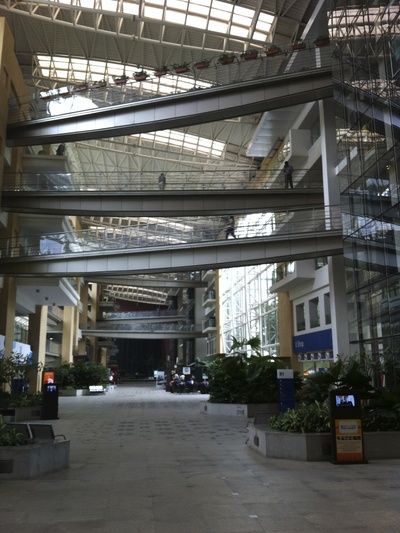- When I see real development on the streets of a foreign city, or when I can view tangible improvements in peoples’ living standards, its one of the most heartening aspects of my job. Unfortunately, not much of this sort of progress was on display during my last trip to Mumbai – it was frustrating to see one of my favorite cities within Asia (seemingly) stagnate.
- However, I am pleased to report on one very positive development within India – one which began at the time of my trip, and which has continued since: the rapid dismantling of excessive bureaucracy and regulatory constraints that surround India’s capital markets.
- While India still faces deep structural problems, the removal of barriers to foreign capital constitutes real progress, and it may help the country deal with some of its chronic trade and fiscal deficits.
On a recent research trip, I returned to Mumbai for the first time in nearly three years.
Mumbai is a humid, raucous, joyous mess. Its streets are chaotic, tangled, and sweltering; from my first visit, the city’s history, people and culture captivated me. I was eager to return on this last trip; but my reunion with Mumbai was somewhat of a let-down, because so little had changed.
It may seem a bit nebulous, but Seafarer’s ultimate goal is to find real progress within the developing world and invest in it. Progress can take myriad forms: it might be a new roadway that alleviates congestion; a technology that boosts fuel efficiency; a public park or an art installation that provides peace to a harried soul; a regulation that prevents market abuse; a prescription that alleviates suffering or that provides a cure. All of these things improve the human condition, and therefore constitute progress. It is this sort of progress that begets growth, and some portion of that progress – the most quantifiable portion – is what we recognize as “GDP growth.” Corporations produce some of that progress; when they do, it creates value for their customers, and this in turn allows them to produce economic profits. If Seafarer can find companies that will achieve steady and meaningful progress, doing so will nearly always coincide with an attractive investment over the long run.
The problem with my trip to Mumbai was that so little progress was evident. Nearly everywhere I looked, the city seemed the same, as if its development had stalled out. The city suffered from the same traffic snarls; the physical infrastructure was still overwhelmed; the international airport’s new terminal was unfinished; shantytowns were still endemic, with no evident improvement in the public housing crisis there.
One of the more gratifying aspects of my job is that it allows me to re-visit places over the span of many years. The physical transformation of a city (i.e. new buildings, skylines, infrastructure) over time is but one way to measure its progress – but it is an important and visible one. It doesn’t necessarily equate with “a great investment opportunity,” yet still, when you can view progress on the streets, and observe tangible improvements in peoples’ living standards, it is heartening. Not so with this trip to Mumbai, and it was disheartening to see one of my favorite cities within Asia (seemingly) stagnate.
Frustratingly, the same held true for a portion of the companies I met in Mumbai. It seemed that many were wrestling with the same problems, bureaucracies and policies that had stifled their growth in the past. To be clear, nothing was obviously worse than usual. Also, I had some great meetings with companies that are making substantial progress in their respective industries, and some have entered (and some may yet enter) the investment portfolio of the Seafarer Fund. Nevertheless, my overall impression was that little had changed, and I felt as though I was stuck in a minor time-warp.
However, there was one very bright spark of progress emanating from India, one which began at the time of my trip, and which has continued since. This event has largely gone mostly unnoticed by the global financial media, mainly because the details are too boring and obscure as to generate attractive headlines. What I am enthused about is the rapid dismantling of excessive bureaucracy and regulatory constraints that have historically fettered the development of India’s capital markets. This change seems to have coincided directly with the introduction of a new Governor at the Reserve Bank of India, Raghuram Rajan; so much so that it is hard for me to believe the two contemporaneous occurrences are only coincidence.
India suffered a minor financial panic this summer, worse than most other emerging markets, and this caused the local currency (the rupee) to plunge in value versus the U.S. dollar. The impetus for the crisis was India’s difficulty in financing its “twin deficits” (trade deficit and fiscal deficits). India’s deficits are structural and so deeply embedded that most observers place little hope in either being rectified. Worse still, the country has historically struggled to fund its deficits, especially because the latter – the country’s fiscal deficit – consumes so much of the nation’s domestic capital.
Over the past decade, India has managed to finance its trade deficits with little stress on the rupee because foreigners were keen to invest in local equities as a means to participate in the country’s growth. Foreigners did so despite a maze of regulations and bureaucracy that served as material impediments to their onshore investment. For reasons both legitimate and archaic, India has been vary wary of opening up to foreign capital. Foreigners who sought an onshore license faced an onerous mess: approval by the regulator could take one to two years, without any clear process to follow, or timeframe to expect (the approval of the Seafarer Fund’s application took approximately 18 months). Foreign fixed income investors often had quotas applied. Some investors waded through that maze, but now that India’s growth has declined, their demand has waned, and less “hot money” (short-term capital investment) has been available to finance the country’s twin deficits. With less inbound capital, the deficits became difficult to balance, and the rupee became vulnerable to correction, and that is exactly what occurred last summer.
What has happened since has been remarkable, albeit obscure. During the late summer of last year, someone, somewhere within India’s constellation of regulators and bureaucrats began to swiftly dismantle the controls that impeded the foreign flow of capital to the country. Someone recognized that India’s domestic capital markets are too small and stunted to provide the requisite finance in the short run, and that the country needs all the financing it can get, from whatever source. Ever since, the obscure but very real barriers to foreign capital have fallen at an astonishing speed.
I don’t use Twitter, but in recent months my inbox has resembled something like a “twitter feed.” It has been lighting up with regular updates from the Seafarer Fund’s custodian, each one announcing how one constraint or another in India has either been simplified or lifted altogether. While each one of these changes is hardly enough to capture headlines – they represent changes in byzantine regulations – cumulatively they are very meaningful, at least in my opinion. It was no surprise to me that the rupee’s rout ceased, and the currency stabilized in the autumn; the measures have already begun to assuage the market’s fears about India’s funding problems. To be sure, India still faces deep structural problems, for which there is no easy solution. Yet at least the country has begun to remove the impediments to its own success. That, in my opinion, constitutes real progress.
Andrew FosterMumbai






- The views and information discussed in this commentary are as of the date of publication, are subject to change, and may not reflect the writer's current views. The views expressed represent an assessment of market conditions at a specific point in time, are opinions only and should not be relied upon as investment advice regarding a particular investment or markets in general. Such information does not constitute a recommendation to buy or sell specific securities or investment vehicles. It should not be assumed that any investment will be profitable or will equal the performance of the portfolios or any securities or any sectors mentioned herein. The subject matter contained herein has been derived from several sources believed to be reliable and accurate at the time of compilation. Seafarer does not accept any liability for losses either direct or consequential caused by the use of this information.
![[Chrome]](/_layout/images/ua/chrome.png)
![[Firefox]](/_layout/images/ua/firefox.png)
![[Opera]](/_layout/images/ua/opera.png)
![[Microsoft Edge]](/_layout/images/ua/edge.png)